|
Volume XX - 1954
Lost Creek Ramblings
By J. Francis Stine, Seasonal Ranger
and Mrs. Marcella Stine
CHAPTER ONE
By J. Francis Stine
Termites to the right, termites to the left! This was our impression
on the night of June 21,1954. We had just retired in our seasonal
quarters at the Lost Creek Ranger Station when this gnawing action
started. Upon investigation it was discovered to be produced by two
porcupines enjoying a "feast" of cabin wood. These porcupine visitations
were common occurrences during the first month of our stay. Porcupine
dinner hours always began around midnight -- we retired at 9:30 p.m. --
and continued until we interrupted their meals (about 12:30 a.m.).
Did you ever try fumbling around in the dark for your shoes,
lighting the lamp and preparing yourself for the brisk evening air, and
upon going outside find Mr. Porcupine in comfort half-way under the
cabin? Best do as we -- return to your bed, pull the covers over your
head and leave the porcupines to their last three or four courses.
It didn't take long to make friends with the golden-mantled ground
squirrels. We spent many early-morning hours feeding them various bits
of food. We found their favorite early-morning course to be cantaloupe.
On July 27, we first noticed the young ground squirrels. There were six
youngsters in the first family that appeared. We frequently placed food
for these ground squirrels on our woodpile.
One morning, July 6, we were startled by a loud chattering. Upon
looking out the window, we observed a pair of gray squirrels, Sciurus
griseus griseus Ord, crossing the yard toward the woodpile. They
investigated the food, but it apparently didn't appeal to them and they
went chattering on their way. These gray squirrels were seen frequently
until the 20th of July. Gray squirrels are rarely seen within the park
boundaries. Previous reports have been for the immediate vicinity of the
South Entrance Ranger Station; this encounter, therefore, provides a new
locality record for the species inside the park.
A large black bear was a frequent visitor in our camping area.
Marmots and conies were observed on hikes to the head of Lost Creek and
along the banks of Sand Creek.
During the first part of July, we observed dozens of western
tanagers picking up nesting materials. We tried very diligently to
locate one of their nests but were unsuccessful. After July 26, we saw
only a few in the area and after August 1, none. The rosy finch was also
a frequent visitor, along with the nuthatch, chickadee, pine siskin,
yellow warbler and red-shafted flicker.
On August 15, while on duty at the entrance station, I saw a fox. He
first appeared about fifty feet away, making his way toward our
quarters. After his second trip over and after an interval of about ten
minutes, he reappeared about twenty-five feet from the station. He
walked very slowly across the road and then stopped. He took one look at
me, sauntered into the trees and then paused. Looking around a tree
trunk, as though he could not believe his own eyes, he seemed to be
thinking to himself, "Look what they are putting in cages now!"
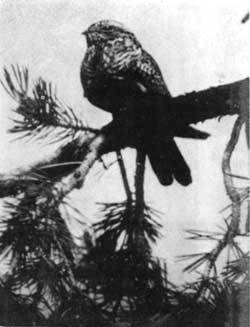
Contrary to the books, this nighthawk sat crosswidse
on a limb
Photo by Welles & Welles
|
CHAPTER TWO
By Mrs. Marcella Stine
On the morning of July 18, my daughter and I were roaming the area
about one-third mile southeast of our Lost Creek cabin, when we
unexpectedly flushed a bird. After some searching, we discovered two
eggs on the ground in front of us. With the help of Ranger Naturalist
Robert Wood, we learned that the bird was a Pacific nighthawk.
We made daily trips to the nest as we wanted to be on hand for the
hatching of the eggs. They hatched a day apart, on July 27 and 28. They
were the darlingest little balls of down we had ever seen. We continued
our daily trips to the nest, in order to keep track of them. On August
1, we found them eight feet from the nest. From that day on, we never
found them in the same place twice. On the 7th, we noticed that they
were full of pin feathers. On the 11th, they were completely feathered
out and were very aggressive for such little fellows.
Despite many trips to the nesting area, we had never seen the male
parent. We were beginning to think that the mother was a widow. We were
very anxious to watch the feeding of the young birds. On the 6th of
August, at 7:30 p.m., I heard an adult bird in the air and knew that
feeding time was at hand. I rushed to the nesting area, darting from
tree to tree as the adult bird glided through the air catching insects.
I managed to get behind a large pine, just eight feet from the young
birds. For several minutes I watched the adult feed the young, thinking
all the while that it was making extraordinarily quick trips back and
forth with food. Then, to my surprise, two birds came down with food at
the same time. This was the first time that any of us had seen the male
for certain.
I went home then, happy to know that the youngsters still had a
father to help look after them.
(Through the efforts and cooperation of the Stine family for about a
month, Ranger Ralph Welles and his wife "Buddy" Welles were able to take
the picture story which follows. - - - Ed.)
Nighthawk Family at Lost Creek
Photos by Ralph Welles & Florence Welles
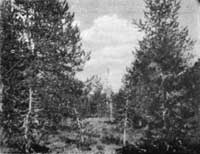
1. Lodgepole pine area where the "nest" was found.
|
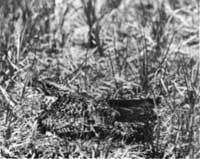
2. The adult would sit on the eggs until approached within
three or four feet.
|
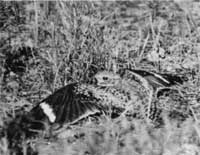
3. Then it would flap away, hissing and moaning, to lead
them from the nest.
|
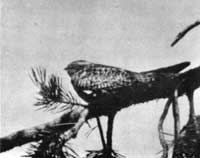
4. Finally, it would fly to a limb, sitting lengthwise,
well-camouflaged.
|
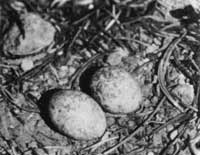
5. Apparently, no preparation is made for the "nest". Nighthawks
often lay eggs on roofs of city buildings.
|
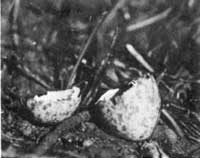
6. Eleven days later, July 30th, only egg shells
occupied the original site.
|
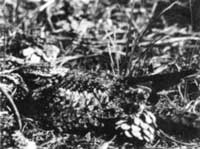
7. A few feet away, the parent bird hovered her small brood.
|
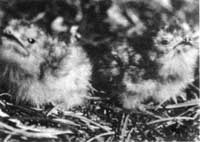
8. Two tiny balls of fluff.
|
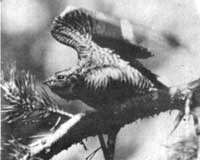
9. This time, the grotesque efforts to lure the intruders
away extended even into the trees.
|
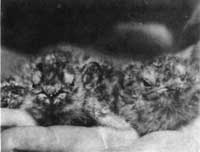
10. Four days later the babies had grown but were still
unafraid. If a hand was placed on the ground near them they would climb
into it.
|
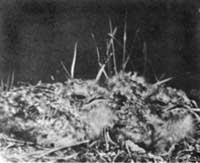
11. August 7th. Pin feathers were beginning to show.
|
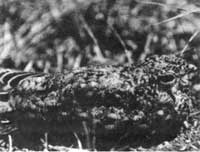
12. August 21st; Three and one-half weeks old. Other
young bird was fully fledged and gone.
|
|

